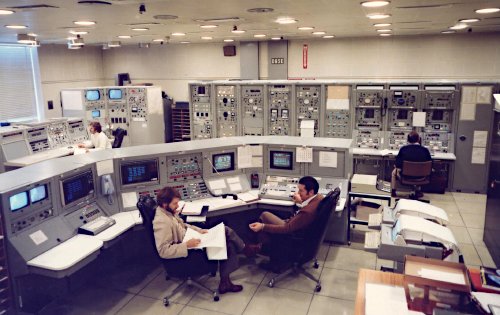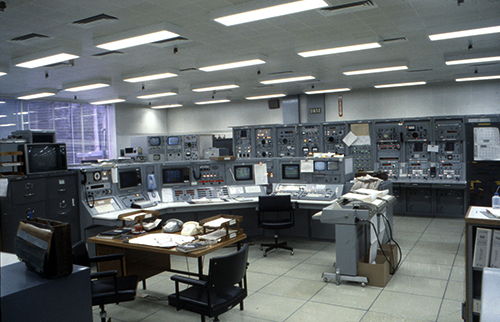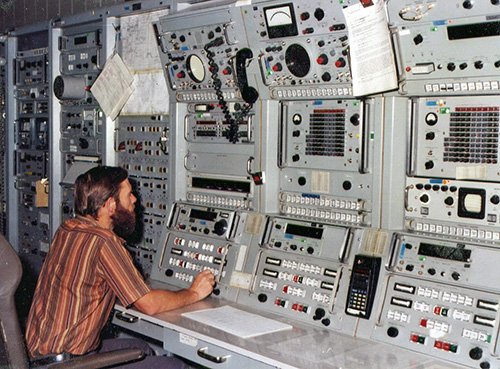The USB and Operations Room at Honeysuckle Creek in the Deep Space era.
Honeysuckle
Tracking Station goes Deep Space
by
Hamish Lindsay
We had quite a lot of experience with deep space tracking before joining the
Deep Space Network full time as we had often helped the Deep Space Station DSS42
at Tidbinbilla in between the manned space missions and Skylab passes.
After the activity and intense pressure with the Manned Space
Flight programs it was like a holiday to join the leisurely (to us) long-term
projects of California’s Jet Propulsion Laboratory’s Deep Space Planetary
Programs. Human lives were no longer at stake – there was much less hype
and media attention if a robot spacecraft was lost in space, and the tracking
procedures were much simpler and low key. Well, for a start there were no voice
communications or medical data to worry about. The critical tracking times were
during planetary encounters, when the data had to be received in real time.
If it was lost there was no second chance.
After Skylab was abandoned for the last time, Honeysuckle Creek left the MSFN
in 1974 and was completely gutted of MSFN equipment, except for the antenna
and servos, and replaced with deep space tracking equipment. I was put in charge
of the dismantling and shipment of all the MSFN equipment and then responsible
for all the station drafting for the new configuration, and of course we all
pitched in to install the equipment when it arrived.
Our staff was reduced, all the managerial and administration functions were
carried out from Tidbinbilla – we became just part of their shift teams.
I took over the Station Director’s office and began working on a Canberra
Space Centre for the public. I lost my Technical Support Section and staff of
five but now had three desks and phone extensions – one for the Space Centre,
one for operations, and the photographic darkroom. I also took on the role of
public affairs officer and gave lectures and media interviews.
Honeysuckle Creek became Deep Space Station DSS44, a companion to DSS42 and
DSS43 at nearby Tidbinbilla, and embarked on the most exciting era of planetary
exploration – a string of first-evers to our planetary neighbours. It continued
the golden era of space exploration begun by Mercury, Gemini and Apollo to which
I was a privileged participant. My friends at Houston told me they were quite
envious of my being a part of the deep space program as there was no way they
could participate from Mission Control in Houston.
We would call the operations centre at JPL (Track) in California “Track”
and when calling the center would say “Track, 44” and they would answer
“44, Track.”
THE JET PROPULSION LABORATORY, JPL
Occupying 145 acres (58.7 hectares) beside a sand and boulder strewn dry riverbed at the foot of the rugged San Gabriel Mountains in California, JPL was formed in October 1936 by the Caltech graduate students as a rocket research laboratory. The less esoteric title of Jet Propulsion Laboratory was chosen for the institution. On 3 December 1958 JPL contracted to NASA and shifted from military rocket research to scientific spacecraft development and promptly began a comprehensive planetary exploration program.
Just before JPL joined NASA, it kick started the whole American space program with the Explorer 1 spacecraft on 31 January 1958. Once it had teamed up with NASA, JPL supported the Apollo Program with the Ranger, Surveyor and Lunar Orbiter programs and initiated the Deep Space Program to explore the planets. JPL beat the Russians to send the world’s first spacecraft to successfully rendezvous with another planet when Mariner 2 reached Venus in December 1962 after a four month journey from Earth.
I visited JPL located in Pasadena, California, in 1990 and was shown over the establishment by Bob Latham, whom I had met on his trips to Australia. It was interesting to see TRACK that I had spoken to over the communication links so many times over the years. TRACK was the operations centre for the JPL tracking network that organised the scheduling and details of the various spacecraft’s tracking periods, issued all the acquisition and handover procedures, and in return soaked up our data from the spacecraft.
DEEP SPACE TRACKING EXPERIENCES AT HONEYSUCKLE CREEK
|
The USB and Operations Room at Honeysuckle Creek in the Deep Space era. It was a home to me – I spent many hours on shift tracking the trailblazing spacecraft such as Helios circling the sun, Pioneer 12 to Venus, the Mars Viking landers, and the Pioneer and Voyager probes to the outer planets. The Operations Console in the foreground with Kevin Gallegos and Les Hughes, the Servo Console with Alan Vonthethoff on the left, the Exciter and Transmitter controls behind in the middle, and Terry Hearn at the Receivers on the right. At times I was the shift supervisor in charge of the station working from the console in the foreground. Kodacolor 4x5 by Hamish Lindsay. |
The USB and Operations Room at Honeysuckle Creek in the Deep Space era. Transparency by Hamish Lindsay. Scan by Colin Mackellar. |
Like the early days of the manned space flights, it was rudimentary tracking in those days when we first joined the Deep Space Network. Of course, we didn’t think so at the time – we were up there with the latest technology doing things that had never been done before.
One example was capturing the spacecraft’s downlink. We would switch on our transmitter and send a signal out to the spacecraft, sometimes simply acquiring a freewheeling downlink, or sometimes taking over from Goldstone in California, when both stations had to follow strict procedures so as not lose the spacecraft signal. We didn’t know what the rest frequency of the spacecraft transponder would be so we had to tune our uplink signal from the lowest point to the highest point of the spacecraft’s spectrum. In those days we had to turn a knob by hand, carefully counting one and a quarter turns of the knob for each second, reading from a clock using Nixie tube numerical displays.
I remember one morning during a Pioneer 11 track at about 0700, at the end of an all-night shift, I had to turn this knob one and a half turns each second for 35 minutes, wait for a minute, then turn it back for another 10 minutes – 1,800 turns without falling asleep at the end of a midnight shift!! If I had jerked the knob, or changed the speed too much I could lose the spacecraft, and have to get Track at JPL in Los Angeles to recalculate a new set of figures, and go through the whole acquiring procedure again. I never did lose a spacecraft, I don’t think any of us did. Later Tidbinbilla and our team tried to couple an electric motor to the knob, but it wasn’t very successful; then as electronics developed JPL designed a very sophisticated box called a POCA which did the whole acquisition procedure electronically to accuracies of millionths of a second. It wouldn’t twitch, get tired, or fall asleep, but could develop faults, and in its early days we could dial in the wrong figures.
|
Me at the Transmitter controls, turning the tuning knob to capture the spacecraft’s transponder. The downlink from the spacecraft was fed from the antenna to the receivers to the right of me. Once It took four hours for my tuning to get to Voyager spacecraft at Saturn and back to the receivers. In those days it was manually tuned (it is automatic now) and once I had to turn it carefully for 35 minutes, turning at one and a quarter turns a second watching the clock right in front of my eyes, wait one minute, then tune back for ten minutes to what we called Tracksyn Frequency. And that at the end of a midnight shift. |
One morning we were driving to work, and as we came around the hill I saw the antenna was still down on the coll tower. They were supposed to be well into the day’s track. My first thought was something’s seriously wrong with the equipment. I went straight to the USB ops area and asked Martin Geasley, the shift supervisor, what was wrong.
“We can’t find the spacecaft. We’ve double checked all the figures, tried everything.
Track can’t come up with any answer.”
“Did you add or subtract the doppler?” I asked.
“We added it, same as we always do,” he replied.
“Well, you should have subtracted it, yesterday it reversed,”
I felt confident this was the problem. They subtracted the doppler and promptly locked onto the spacecraft. Which just goes to show how such a simple thing as a plus or minus sign can make the difference between success or failure.
(Written 2003.)


